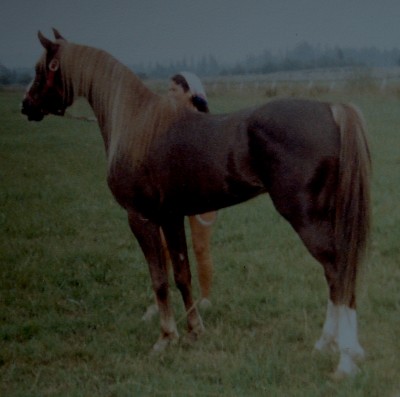Naizahq, 1977 asil Dahman Shahwan stallion in Canada
Another asil horse bred and owned Lee Oellerich in Canada was the 1977 asil stallion Naizahq (Mirath x Dahma al-Shaqra by Ruta-Am), also a Dahman Shahwan of the Bahraini line that traces back to *Sawannah.
Lee tells me:
“He is a winnner of numerous match races, against all comers, including English Thoroughbreds (TB). He ran 4 F. (1/2 M.) in 47.2 and beat a TB in a morning work, carrying close to 20 pounds more than the TB. He sprinted a F. (1/8 M.) in 11 seconds. He could also run a distance and beat TB’s over 1-1/2 and 2 mile match races. Many Arabians ate his dust, mostly in 1/2M. and 1M. Races. Typically they would, get a 5 to 10 length moving start, and he would break from a starting gate. He also won over his sire Mirath, by a head, in a 5 F. Race.

Magnificent horse. Sad that there is not more of his blood in today’s horses.
I agree.
Just look at how well he is put together. Escpecially the size of his bone. No tooothpick legs here!
Bruce Peek
Joe you are right its sad really i really wish there are indviduals like him alive .
As I look at this picture again and read the description of Naizaqh’s accomplishments I reflect on how the mainstream seems to have been unable to maintain continuity of thought about the Arabian horse from the times past. In the first quarter of the 20th century North America had numerous excellent horsemen who appreciated the Arabian horse for what it originally was, people such as Spencer Borden, Homer Davenport, W.R. Brown, Albert Harris etc. In their time, a horse like this would have been taken seriously and he would likely have had a much greater impact. This should remind us of the importance of being vigilant now in communicating to the the new generations of Arabian enthusiasts that these are the original horses, not alternates. In modern times it is a changing culture. One cannot blame people for making choices only from what they know now. One must find ways to bring the stories of the past into the modern culture so that it is convincingly a part of the present and a part of the modern vocabulary of the Arabian horse. Perhaps we need to have a classic Bedouin campfire gathering at a future Al Khamsa convention?
How about preservation organizations promoting endurance racing more seriously?
Fun races, no rewards, just for the fun doing. Maybe at Al Khamsa events. No race track, just open out door race. One end of the field and back. Big field!
How about combined training? I mean something on the order of a one day horse trial. Dressage, to make sure they can stop, start, turn left and right and backup straight. Then of course a cross country phase, jumping up to three feet with a maximum four foot spread- downhill-uphill and on a side of a hill too, through water and off a bank or two. And then finish it off with a round of Arena jumping. And then those that have not been pulled yet would do say a 50 mile endurance ride. Then you would have demonstrated the steel that lies beneath.
Speaking of W.R. Brown he is listed as the breeder of Gharis. To mee Gharis looks so much more desertlike than the horses you see nowadays.
Best wishes
Bruce Peek
Bruce, I would like to add confirmation inspection to the proposed combined training. A judge/judges will evaluate on the quality of conformation (made up of scores for head, neck, frame, fore limbs and hind limbs), correctness of gaits and temperament.
This process will help me and the new generations to select Asil stallion for breeding. Am not knowledgeable about confirmation as our long time breeders, who can look at young foal and tell how they will look like matured.
Dear Bassam: Don’t kid yourself about breeders, long time and otherwise. The way they develop the ability to look at a colt and tell you how they will turn out is having done that breeding- same sire and dam several times previously. Your idea of having a judge evaluate the stock in question has merit. How about if Edouard could somehow arrange to get some tribal breeders to be the judges. And have them make reccomendations as to how a particular Stallion or Mare could best be bred- as opposed to ranking the horses with first, second, or third places.
Best Wishes
Bruce Peek